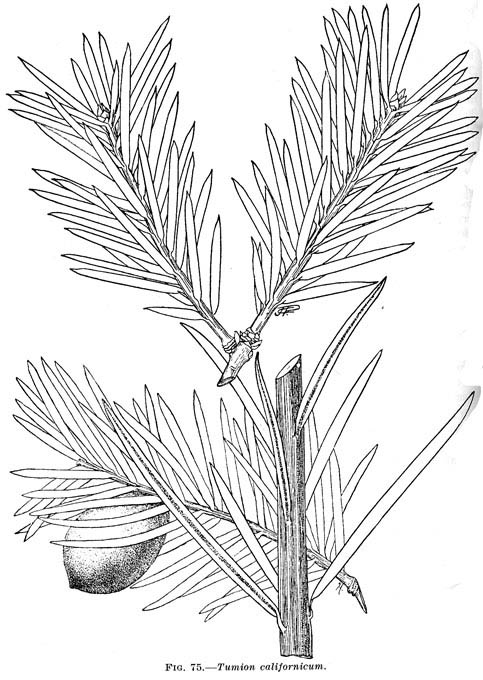Torreya californica
 California nutmeg
California nutmeg
A dark evergreen tree with the general appearance of a yew. The leaves are flat needles about 2 inches long with two pale lines on the undersurface and with a sharp point; they were used for tattooing by the Pomo. The nutmegs that give the tree its name are like large olives with very little meat. California nutmeg is native to the Santa Cruz Mountains between Stanford and the ocean. Stanford botanist William Dudley reported a California nutmeg near the Arizona Garden in his 1909 inventory of conifers; it has disappeared in recent years. California nutmeg would be most suitable for use on campus, and Magic, Inc., is trying to reestablish it. In 2003 the group planted one small tree on the Galvez side of the Stanford Stadium berm, just above the men’s restroom, and another about 60 feet south of the fence that is south of the vernal pool located near Palm Drive and El Camino Real (along the pedestrian extension of Lasuen Street). Both were planted from one gallon stock purchased at Yerba Buena Nursery, and were in 3-foot, green Tubex tree shelters.
The wood was used for bows by Californian Indians, as was the wood of the related yew in England, and the nuts were eaten after suitable preparation. Since yew seeds are poisonous, it would be unwise to experiment incautiously. When crushed, the foliage smells like bay leaf.
There are other species of Torreya in the world; the nuts of T. nucifera in Japan were eaten and provided oil, T. taxifolia in Florida was thought to be probably extinct in its original habitat, but the University of California at Santa Cruz has come to its rescue by planting a small grove in its arboretum. Taxol, a substance isolated from the California nutmeg, was found to be of interest in treating cancer, creating a worrying dilemma, since the wild tree is not abundant. The dilemma has been resolved, however, by successful synthesis of this substance. This is fortunate because the only other known natural source of taxol is a fungus associated with the roots of the quarantined Wollemi pine.
Taxus brevifolia of the family Taxaceae is the Pacific yew tree, which is native to the Pacific Northwest of the United States, had been the main natural source of Taxol (“Taxus sp. and the Ethnobotanical and Chemical Origins of Taxol,” Dan McDonley).
Name derivation: Torreya – Dr. John Torrey (1796–1873), who co-authored with Asa Gray the first Flora of North America; californica – of California.
About this Entry: The main text of this entry is from the book Trees of Stanford and Environs, by Ronald Bracewell, published 2005. John Rawlings added more details on the Magic plantings and the note on Taxus brevifolia ca. 2005.




